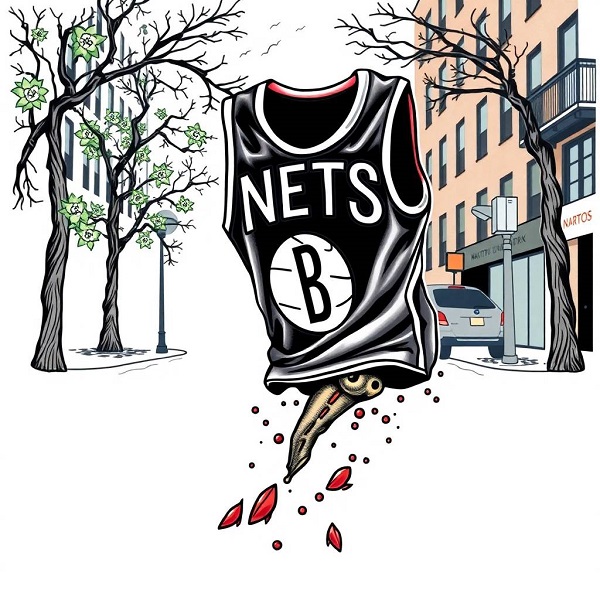All sorts of dumb things are flying around, this Giannis to Nets story is possibly the worse. Why on earth would he leave a team optimised around him for one near the bottom of the league?
1. Lack of Trade Assets
The Nets are in a rebuilding phase after the Kevin Durant, Kyrie Irving, and James Harden era left them with limited draft capital and young talent. To acquire a superstar like Giannis, Milwaukee would demand a hefty package, likely including multiple first-round picks, promising young players, and possibly an All-Star caliber player. Brooklyn’s most valuable assets include:
- Cam Thomas, a scoring guard with potential but inconsistent defense and playmaking.
- Nic Claxton, a solid defensive center but not a cornerstone for a contending team.
- Draft picks, many of which are controlled by other teams (e.g., Houston owns Brooklyn’s 2026 and 2027 first-rounders due to the Harden trade).
The Nets simply don’t have the blue-chip prospects or picks to entice Milwaukee, especially since the Bucks would want players who fit their timeline and complement their roster around Damian Lillard. Trading Giannis for a package centered around Thomas, Claxton, and limited picks wouldn’t align with Milwaukee’s goal of staying competitive.
2. Financial Constraints
Giannis is in the first year of a three-year, $175.3 million extension, with a cap hit of approximately $58.6 million in 2025-26. The Nets, while not hard-capped, are managing their salary sheet carefully to maintain flexibility during their rebuild. Adding Giannis’s massive contract would limit their ability to build a balanced roster around him, especially since Brooklyn lacks the depth to compete immediately. The luxury tax implications and the cost of re-signing players like Claxton or adding role players would strain their financial resources.
3. Strategic Misalignment
The Nets are focused on developing young talent and accumulating assets for long-term success, not mortgaging their future for a single star. General Manager Sean Marks has emphasized patience, as seen in their refusal to overpay for players in recent trade discussions. Trading for Giannis would mean doubling down on a win-now strategy, which contradicts their current direction. Brooklyn’s front office is more likely to target players who fit their timeline, such as high-upside prospects or cost-controlled veterans, rather than a 30-year-old superstar whose prime may not align with their competitive window.
Why Giannis Wouldn’t Thrive in Brooklyn
Even if the Nets could pull off a trade, Giannis’s fit with the team raises significant concerns. His game, while dominant, has weaknesses that Brooklyn’s current roster and infrastructure wouldn’t address, and the move wouldn’t automatically make them championship contenders.
1. Lack of Complementary Star Power
Giannis thrives when surrounded by players who can space the floor, handle the ball, and share the offensive load. In Milwaukee, players like Khris Middleton and Damian Lillard provide shooting and playmaking, allowing Giannis to dominate in the paint and on drives. The Nets, however, lack a secondary star to complement him:
- Cam Thomas is a score-first guard who struggles with efficiency (42.7% FG in 2024-25) and doesn’t create for others (2.8 assists per game).
- Dennis Schröder, while a solid point guard, is better suited as a sixth man or secondary playmaker, not a co-star.
- Ben Simmons, if healthy, could theoretically pair with Giannis as a playmaker and defender, but his inability to shoot (0% from three) clogs the lane and undermines spacing.
Without a true co-star, Giannis would face the same defensive schemes that have challenged him in the playoffs—packed paint, sagging defenders, and double-teams—forcing him to rely on his inconsistent jumper or limited playmaking.
2. Spacing and Offensive Fit
Giannis’s game relies heavily on driving lanes and interior dominance, which requires shooters to stretch the floor. The Nets’ current roster lacks consistent outside shooting:
- Brooklyn ranks 22nd in three-point percentage (34.8%) and 19th in three-pointers made per game (12.4) in the 2024-25 season.
- Key rotation players like Claxton and Simmons are non-shooters, and Thomas’s three-point shooting (36.1%) is respectable but not elite.
- Role players like Dorian Finney-Smith (35.5% from three) and Jalen Wilson (33.3%) don’t provide enough volume to punish defenses.
In Milwaukee, Giannis benefits from shooters like Middleton (38.1% from three) and Brook Lopez (36.5%), who force defenders to stay honest. In Brooklyn, defenses could sag off non-shooters, daring Giannis to shoot from deep, where he’s struggled (career 28.5% from three, 29.1% in 2024-25). The Nets’ lack of spacing would exacerbate Giannis’s limitations as a half-court scorer.
3. Defensive Concerns
Giannis is a Defensive Player of the Year (2020) and one of the league’s best rim protectors, but he can’t single-handedly fix a team’s defense. The Nets rank 18th in defensive rating (113.2) in 2024-25, with weaknesses in perimeter defense and transition. Players like Thomas and Schröder are average defenders at best, and Simmons’s defensive impact has waned due to injuries and inconsistent effort. While Giannis and Claxton could form a formidable frontcourt defensively, the backcourt’s deficiencies would leave Brooklyn vulnerable to guards like Jayson Tatum, Donovan Mitchell, or Tyrese Haliburton in playoff matchups.
4. Coaching and Infrastructure
The Bucks’ system under coaches like Mike Budenholzer and Doc Rivers has been tailored to maximize Giannis’s strengths, with an emphasis on pace, transition, and defensive versatility. In contrast, Nets head coach Jordi Fernández is still establishing his system, focusing on player development and ball movement. While Fernández is a promising coach, it’s unclear whether he could immediately design an offense that hides Giannis’s weaknesses, especially with a roster not built for his style. Additionally, Brooklyn’s lack of playoff experience as a unit could hinder their ability to compete in high-stakes games, even with Giannis.
Giannis’s Weaknesses: Unaddressed in Brooklyn
Giannis’ game has well-documented limitations that have been exposed in playoff settings. A move to Brooklyn wouldn’t solve these issues and could even amplify them.
1. Limited Outside Shooting
Giannis’s three-point shooting remains a work in progress. In the 2024-25 season, he’s averaging 1.2 threes made on 4.1 attempts (29.1%), and his midrange game is inconsistent. In playoff series, teams like the Miami Heat (2020) and Toronto Raptors (2019) have built walls in the paint, forcing him to shoot or pass. The Nets’ lack of elite shooters and playmakers would allow opponents to employ similar strategies, putting more pressure on Giannis to create outside the paint—an area where he’s still developing.
2. Playmaking Under Pressure
Giannis’s playmaking has improved (6.0 assists per game in 2024-25), but he’s not a natural point-forward like LeBron James. In crunch time, he often relies on teammates to initiate offense or make decisions. Without a primary ball-handler like Lillard or Jrue Holiday, Giannis would face increased ball-handling duties in Brooklyn, potentially leading to turnovers (3.2 per game in 2024-25) or stagnant possessions.
3. Free-Throw Struggles
Giannis’s free-throw shooting (67.1% in 2024-25) remains a liability in close games, where hacking strategies can disrupt his rhythm. The Nets’ lack of clutch performers (Thomas is their primary late-game option) means Giannis would face even more pressure at the line, with no reliable fallback option to bail out the offense.
4. Injury and Workload Concerns
At 30 years old, Giannis has logged heavy minutes (33.8 per game in 2024-25) and taken significant physical punishment due to his aggressive style. The Nets’ thin roster would force him to carry a massive load on both ends, potentially increasing injury risk. Milwaukee’s depth allows Giannis to conserve energy for key moments, a luxury Brooklyn can’t offer.
Championship Contender? Not in Brooklyn
Even with Giannis, the Nets wouldn’t be immediate championship contenders. The Eastern Conference is stacked with teams like the Boston Celtics, Philadelphia 76ers, and New York Knicks, all of whom have deeper rosters and better cohesion. Boston’s versatile wings (Tatum, Jaylen Brown) and shooting would exploit Brooklyn’s lack of perimeter defense and spacing. Philadelphia’s Joel Embiid and Tyrese Maxey would overwhelm the Nets’ backcourt, and the Knicks’ physicality and depth would pose matchup problems.
To become contenders, the Nets would need to add a second star, elite shooters, and defensive specialists around Giannis—moves that are nearly impossible given their limited assets and cap space. Without these pieces, Giannis would be in a similar position to his early Milwaukee years: a dominant force surrounded by a roster not ready to compete at the highest level.
Get real!
The Brooklyn Nets are unlikely to trade for Giannis Antetokounmpo due to their lack of trade assets, financial constraints, and rebuilding strategy. Even if they could acquire him, Giannis wouldn’t find the ideal environment to overcome his weaknesses or lead the Nets to a championship. His need for spacing, complementary star power, and a tailored system wouldn’t be met by Brooklyn’s current roster, and the team’s defensive and depth issues would persist. For now, Giannis is better suited to stay in Milwaukee, where the Bucks are built to maximise his strengths, while the Nets focus on their long-term vision.

